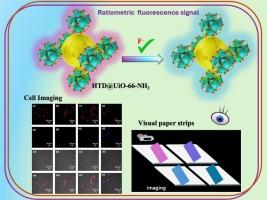A two-emitting dye-embedded fluorescent sensor based on zirconium MOF for effective detection of fluoride
IF 4.6
2区 化学
Q1 SPECTROSCOPY
Spectrochimica Acta Part A: Molecular and Biomolecular Spectroscopy
Pub Date : 2025-09-21
DOI:10.1016/j.saa.2025.126949
引用次数: 0
Abstract
Ratiometric fluorescent (RF) sensors, leveraging their inherent calibration mechanism, can greatly reduce the interference of irrelevant factors and exhibits superior detection sensitivity and more attractive visual detection effects in the process of quantitative analysis. Up to now, there are few probes that can detect fluorine by the proportional fluorescence signal. Herein, we constructed a RF probe for determination of fluorine by confining self-synthesized red emitting organic small molecules 10-(diethylamino)-3-hydroxy-5,6-dihydrobenzo[c]xanthen-12-ium (HTD) into the microchannels and cavity structures of UiO-66-NH2, exhibiting two emission maxima at 428 nm and 616 nm, respectively. After introducing fluoride into the system of probe, a drastic fluorescence enhancement at 428 nm was emerged, whereas the emission peak at 616 nm underwent minor fluctuations. The probe that has been developed enables the sensitive and selective detection of fluoride ions, exhibiting excellent linear relationships in the range of 0–100 μM. The detection limit value was estimated to be 6.93 μM. This unique ratiometric luminescence behavior of probe toward fluoride resulted from the creation of hydrogen bonds between fluoride and amino groups in HTD@UiO-66-NH2. Notably, the probe could utilize as an effective tool for detecting fluoride in cells with high-quality results, which could have important implications for research in biology, toxicology, and related fields. Simultaneously, its corresponding portable online test strips can be easily acquired and employed for fluoride detection through visual colorimetric analysis. The proposed method offers an alternative technology for quantifying fluoride levels in real-life water samples.

一种基于锆MOF的双发射染料嵌入荧光传感器,用于氟化物的有效检测。
比率荧光(RF)传感器利用其固有的校准机制,可以大大减少无关因素的干扰,在定量分析过程中表现出优越的检测灵敏度和更吸引人的视觉检测效果。到目前为止,能够利用比例荧光信号检测氟的探针很少。本研究通过将自合成的红色发光有机小分子10-(二乙基氨基)-3-羟基-5,6-二氢苯并[c]杂原-12 (HTD)限制在uo -66- nh2的微通道和空腔结构中,构建了检测氟的射频探针,分别在428 nm和616 nm处表现出两个发射峰值。在探针系统中引入氟化物后,在428 nm处出现了剧烈的荧光增强,而在616 nm处的发射峰出现了轻微的波动。所开发的探针能够灵敏和选择性地检测氟离子,在0-100 μM范围内表现出良好的线性关系。检测限为6.93 μM。这种独特的比例发光行为的探针对氟化物的产生是由于氟化物和氨基之间的氢键在HTD@UiO-66-NH2。值得注意的是,该探针可以作为一种有效的工具来检测细胞中的氟化物,并获得高质量的结果,这可能对生物学、毒理学和相关领域的研究具有重要意义。同时,其相应的便携式在线试纸可以很容易地获得,并通过视觉比色分析用于氟化物检测。所提出的方法提供了一种可替代的技术来量化现实生活中水样中的氟化物水平。
本文章由计算机程序翻译,如有差异,请以英文原文为准。
求助全文
约1分钟内获得全文
求助全文
来源期刊
CiteScore
8.40
自引率
11.40%
发文量
1364
审稿时长
40 days
期刊介绍:
Spectrochimica Acta, Part A: Molecular and Biomolecular Spectroscopy (SAA) is an interdisciplinary journal which spans from basic to applied aspects of optical spectroscopy in chemistry, medicine, biology, and materials science.
The journal publishes original scientific papers that feature high-quality spectroscopic data and analysis. From the broad range of optical spectroscopies, the emphasis is on electronic, vibrational or rotational spectra of molecules, rather than on spectroscopy based on magnetic moments.
Criteria for publication in SAA are novelty, uniqueness, and outstanding quality. Routine applications of spectroscopic techniques and computational methods are not appropriate.
Topics of particular interest of Spectrochimica Acta Part A include, but are not limited to:
Spectroscopy and dynamics of bioanalytical, biomedical, environmental, and atmospheric sciences,
Novel experimental techniques or instrumentation for molecular spectroscopy,
Novel theoretical and computational methods,
Novel applications in photochemistry and photobiology,
Novel interpretational approaches as well as advances in data analysis based on electronic or vibrational spectroscopy.

 求助内容:
求助内容: 应助结果提醒方式:
应助结果提醒方式:


